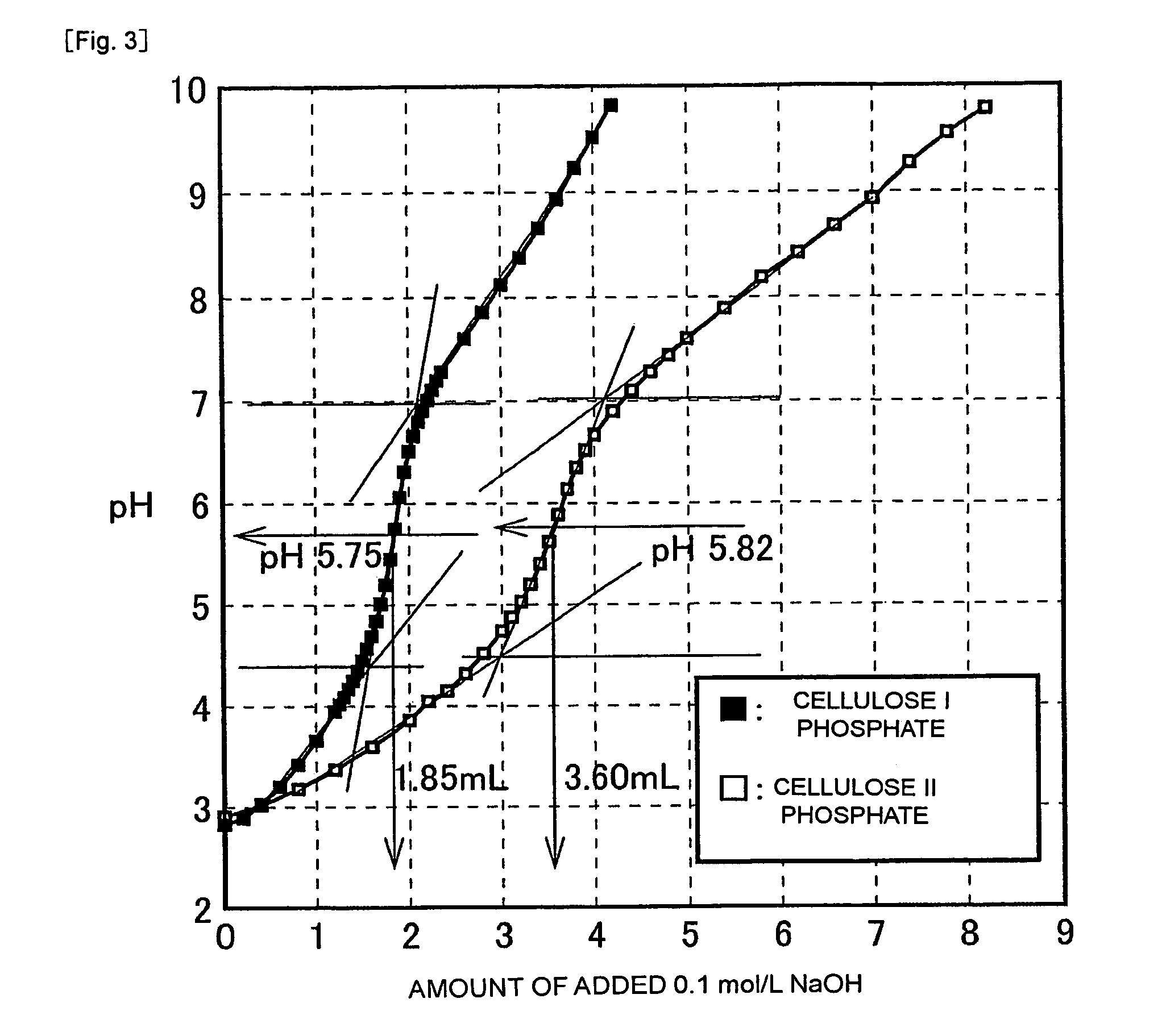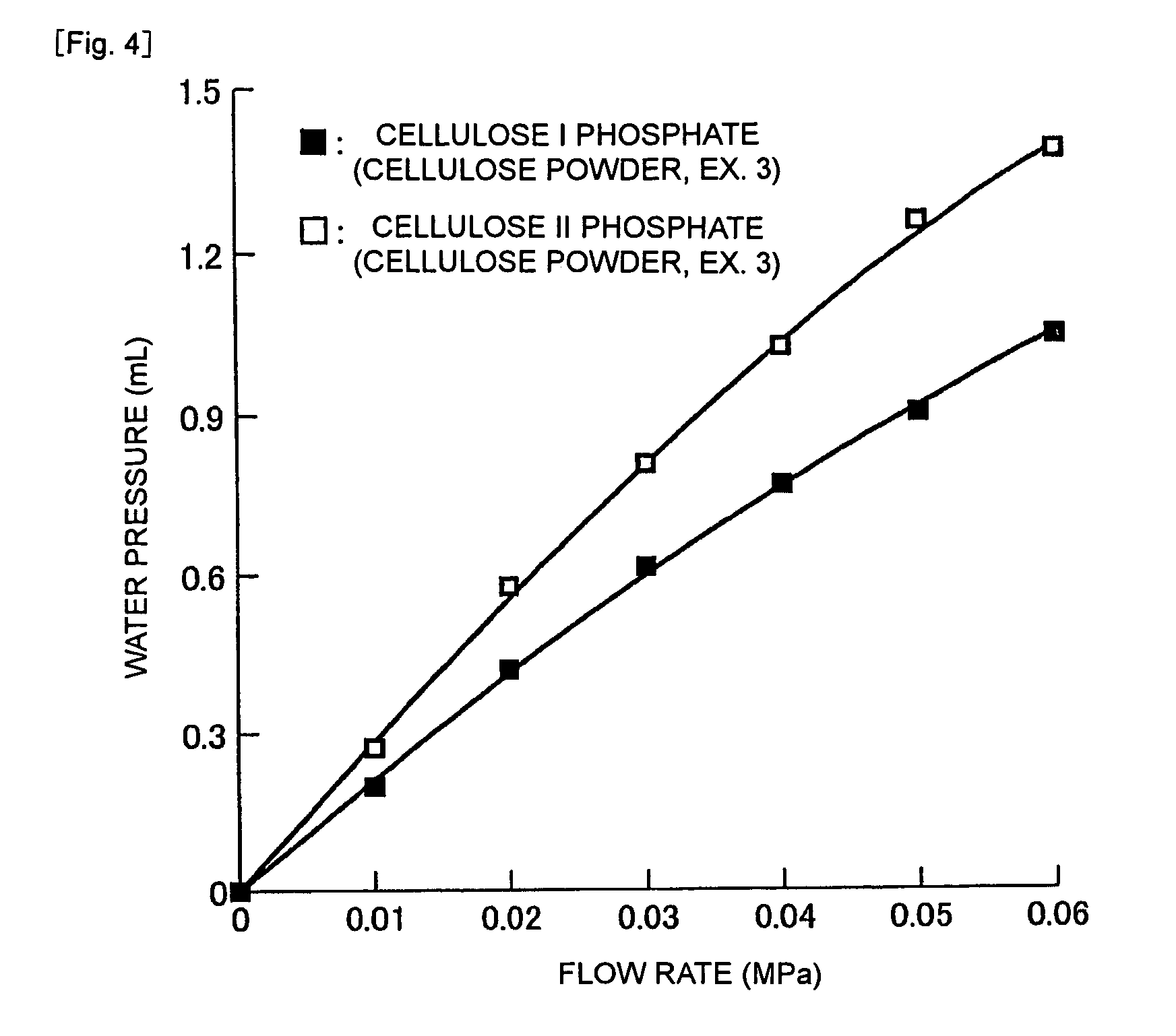Cellulose II phosphate ester and metal-adsorbing material using the same
a technology of cellulose ii and phosphate ester, which is applied in the direction of sugar derivates, water/sewage treatment by ion exchange, etc., can solve the problems of low speed of diffusion of metal ions or regenerants into resin, waste of water resources, etc., to achieve excellent water permeability, high metal adsorption capacity, and excellent water softening
- Summary
- Abstract
- Description
- Claims
- Application Information
AI Technical Summary
Benefits of technology
Problems solved by technology
Method used
Image
Examples
examples
[0045]The present invention will hereinafter be specifically described based on Examples. It should, however, be borne in mind that the present invention is not limited to these Examples.
Measuring Method of the Amount of Adsorbed Metal
[0046]The amount of a metal adsorbed on a metal-adsorbing material was measured by the following measuring method.
[0047]The metal-adsorbing material (W g), which was optionally cut into small pieces as needed, was added to an 10 mmol / L aqueous solution (V L) of the metal, followed by thorough dispersion. After the thus-obtained mixture was stirred at room temperature (25° C.) for 24 hours, an aliquot (0.5 mL) of the aqueous solution was collected in a 1.5-mL Eppendorf centrifugal tube, and was then centrifuged at 12,000 r / min (rotor diameter: approx. 9 cm) for 10 minutes to have the powder precipitated, thereby obtaining its supernatant. An aliquot (X mL) of the supernatant was sampled, 0.1 mol / L nitric acid (Y mL) was added to dilute the supernatant a...
production example
Production of Cellulose II by High Alkali Treatment
[0048](1) A 10 mol / L aqueous solution of sodium hydroxide (100 mL) was added to natural cellulose powder (cotton linters; 10 g), followed by stirring at room temperature (25° C.) for 2 hours. The mixture was then washed with water to remove the alkali, water was removed by filtration, and the residue was dried at 70° C. for 6 hours to afford a cellulose II material A.
[0049](2) A 10 mol / L aqueous solution of sodium hydroxide (20 mL) was poured over a cotton fabric (terry cloth; dry weight: 10 g) spread in a glass container to soak the cotton fabric with the aqueous solution, and the soaked cotton fabric was then allowed to stand at room temperature (25° C.) for 2 hours. Subsequently, the cotton fabric was washed with water to remove the alkali, wringed well to remove water, and then dried at 70° C. for 6 hours to afford a cellulose II material B.
[0050](3) A 10 mol / L aqueous solution of sodium hydroxide (50 mL) was added to natural ce...
example 1
[0051](1) A phosphorylating chemical solution, which had been prepared by dissolving phosphoric acid (0.015 mol), diammonium hydrogenphosphate (0.02 mol) and urea (0.1 mol) in water (15.0 mL), was added to the cellulose II material C (1 g). The thus-prepared mixture was thoroughly mixed, was allowed to stand at room temperature (25° C.) for 1 hour, and then, was completely dried at 90° C. for 6 hours. Subsequently, the mixture was heated to 150° C., followed by a reaction at that temperature for 2 hours. The reaction product was then washed with water and dried (at 70° C.) to afford cellulose II phosphate (fibers).
[0052](2) The thus-afforded cellulose II phosphate, cellulose I phosphate afforded by phosphorylating natural cellulose fibers (ramie), and their raw materials, i.e., cellulose II and cellulose I (natural cellulose fibers (ramie)), respectively, were each subjected to an elemental analysis. The following results were obtained.
[0053]
Cellulose II phosphate:C 22.01%, H 4.86%,...
PUM
| Property | Measurement | Unit |
|---|---|---|
| temperature | aaaaa | aaaaa |
| pH | aaaaa | aaaaa |
| temperature | aaaaa | aaaaa |
Abstract
Description
Claims
Application Information
 Login to View More
Login to View More - R&D Engineer
- R&D Manager
- IP Professional
- Industry Leading Data Capabilities
- Powerful AI technology
- Patent DNA Extraction
Browse by: Latest US Patents, China's latest patents, Technical Efficacy Thesaurus, Application Domain, Technology Topic, Popular Technical Reports.
© 2024 PatSnap. All rights reserved.Legal|Privacy policy|Modern Slavery Act Transparency Statement|Sitemap|About US| Contact US: help@patsnap.com










